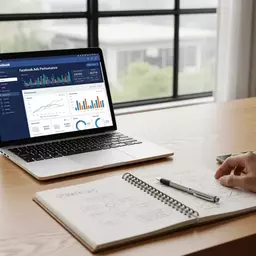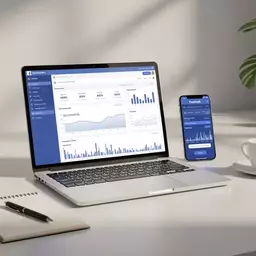Target Niche Audiences on Facebook

Posted on: 2025-10-16
By: Elena Fitzgerald
Effective Facebook advertising hinges on one crucial element: targeting. Did you know that refining your audience can significantly boost ad performance and ROI? Understanding how to leverage Facebook's detailed targeting tools is essential for anyone looking to maximize their advertising efforts.
What You Will Learn
- The importance of detailed targeting in Facebook ads to avoid wasted ad spend.
- How to utilize demographics, interests, and behaviors for precise audience selection.
- The value of Custom and Lookalike Audiences in enhancing your advertising strategy.
- Key metrics to track post-campaign for analyzing ad performance and ensuring continuous improvement.
Key Metrics and Audience Types for Facebook Ads
This visual highlights the essential metrics for tracking Facebook ad performance and the powerful audience types available for enhanced targeting. Understanding these elements is crucial for optimizing campaigns and achieving better ROI.
Key Metrics to Monitor
- • Reach: Unique users who saw your ad.
- • Impressions: Total ad displays.
- • Clicks: User interactions with ad link.
- • CTR: Percentage of clicks.
- • Conversions: Desired actions completed.
Detailed Targeting Methods
- • Demographics: Age, gender, education.
- • Interests: Hobbies, likes, activities.
- • Behaviors: Purchasing habits, device usage.
— Helps create highly relevant ad experiences.
Advanced Audience Types
- • Custom Audiences: From customer lists, website traffic.
- • Lookalike Audiences: New users similar to best customers.
— Nurture existing and find new potential buyers.
Optimization Strategies
- • A/B Testing: Compare ad variations.
- • Targeting Adjustments: Refine audience.
- • Budget Allocation: Shift to high performers.
- • Creative Refresh: New visuals/messaging.
Understanding Facebook Detailed Targeting for Australian Niches
When it comes to Facebook advertising, one of the most crucial elements to grasp is detailed targeting. This feature allows you to reach specific audiences that are most likely to engage with your business. For Australian companies, understanding how to refine your audience can result in better ad performance and higher returns on investment. Let’s explore why targeting is so important and how it works!
Imagine putting your ads in front of the right eyes—those who are genuinely interested in your product or service. By honing in on the right audience, you not only save money but also increase your chances of conversion. This is why mastering Facebook’s targeting tools is essential for any small business owner or marketer in Australia. For a deeper understanding of audience targeting strategies, consider resources like Kontentino's guide on Facebook ads target audiences.
The Importance of Targeting in Facebook Ads
Effective targeting can make or break your Facebook ad campaigns. Without it, your ads may end up in front of individuals who have no interest in what you offer. This not only leads to wasted ad spend but can also diminish your brand's credibility. So, how do we ensure our ads reach the desired audience?
- Identify specific demographics, such as age and gender.
- Pinpoint interests and behaviors relevant to your niche.
- Utilize location targeting to reach users in targeted regions.
- Experiment with custom audiences based on existing customer data.
By breaking down your audience with these criteria, you can create more personalized ad experiences that resonate with potential customers. This tailored approach is not just effective; it’s essential for standing out in today’s competitive digital landscape! To learn more about the extensive targeting capabilities of Facebook Ads, this resource from Search Engines Marketer offers valuable insights.
How Facebook Detailed Targeting Works
Facebook’s detailed targeting feature allows you to narrow down your audiences based on various factors. This includes demographics, interests, and behaviors. But how does it actually work? Let’s dive into the mechanics!
- Demographics: Choose criteria such as age, gender, and education level.
- Interests: Target users based on their hobbies, likes, and activities.
- Behaviors: Reach people based on their purchasing habits and device usage.
By combining these elements, you can create highly targeted ads that speak directly to your audience’s needs and preferences, making them much more likely to engage with your business.
Exploring Custom and Lookalike Audiences for Enhanced Targeting
In addition to detailed targeting, Facebook offers powerful options like Custom Audiences and Lookalike Audiences that can enhance your advertising strategy significantly. Custom Audiences let you reach people who have already interacted with your business, such as website visitors or previous customers. This is where you can nurture existing relationships and maximize conversions.
- Custom Audiences: Build audiences from your customer lists, website traffic, or app activity.
- Lookalike Audiences: Target new users who share similar characteristics with your best customers.
Utilizing these audience types not only broadens your reach but also increases your chances of connecting with potential buyers who are likely to appreciate your offerings. At Facebook Ads Australia, I encourage you to leverage these tools to take your campaigns to the next level! For broader context on Facebook's immense reach and user base, which underscores the importance of effective targeting, explore Sprout Social's Facebook stats for marketers.
Preparing to Set Up Your Facebook Ads
Now that we’ve covered the basics of targeting, it's time to prepare for setting up your Facebook ads. Understanding your audience is key, especially in the diverse and unique Australian market.
We Want to Hear From You!
What aspect of Facebook detailed targeting do you find most challenging? Share your thoughts below:
Frequently Asked Questions about Facebook Detailed Targeting
Measuring Success: Tracking Your Facebook Ads Performance
Now that your Facebook ads are up and running, it's essential to track their performance. Understanding how well your campaigns are doing can help you make informed decisions for future ads. In this section, we'll dive into the key metrics you should monitor after your campaigns have launched.
When it comes to measuring success, data is your best friend! Facebook provides a wealth of analytics tools to help you gauge engagement, reach, and conversions. But which metrics are the most important? Let’s break it down.
Key Metrics to Monitor Post-Campaign
Tracking the right metrics can reveal valuable insights about your ad performance. Here are some key metrics that I recommend you keep an eye on:
- Reach: The number of unique users who saw your ad.
- Impressions: The total number of times your ad was displayed, even if it was seen by the same user multiple times.
- Clicks: How many users clicked on your ad link to learn more or take action.
- Click-Through Rate (CTR): The percentage of people who clicked on your ad after seeing it.
- Conversions: The number of users who completed the desired action, such as making a purchase or signing up for a newsletter.
These metrics will provide a comprehensive picture of how your ads are performing. By analyzing them, you can identify trends and adjust your strategy accordingly. For example, if your CTR is low, it might be time to rethink your ad creative or target audience.
Understanding Engagement Metrics: Reach and Impressions
It's crucial to differentiate between reach and impressions. Reach tells you how many unique users have seen your ad, while impressions show how often your ad has been displayed. High impressions with low reach may indicate that your ad is being shown repeatedly to a limited audience. This could lead to ad fatigue, where users become less responsive over time.
By paying attention to these engagement metrics, you can better understand your audience's behavior and refine your targeting strategies to ensure your ads resonate effectively.
Optimizing Future Campaigns Based on Insights
Once you’ve gathered data from your initial campaigns, it’s time to use those insights to optimize future efforts. This is where the magic happens! Let’s explore how to leverage the data you've collected for better results.
- A/B Testing: Test different ad variations to see which performs better. You can tweak elements like the images, headlines, or call-to-action buttons.
- Targeting Adjustments: Use insights to refine your audience targeting—maybe you need to narrow your niche or broaden it, depending on performance.
- Budget Allocation: Shift your budget towards high-performing ads to maximize your ROI.
- Creative Refresh: If an ad isn’t performing well, experiment with new visuals or messaging to capture attention.
Each campaign you run is a learning opportunity. By consistently analyzing and applying what you've learned, you’ll be on your way to creating effective, data-driven ads that resonate with your audience!
Leveraging A/B Testing for Enhanced Results
Implementing A/B testing can significantly improve your ad performance. This method involves running two versions of an ad simultaneously to see which one performs better. By comparing results, you can determine which elements are most effective in engaging your audience.
For instance, you might test different images or headlines to see which generates more clicks. This not only helps you optimize your current campaigns but also informs future strategies. So, get creative and start experimenting!
Recap of Key Points
Here is a quick recap of the important points discussed in the article:
- Effective Facebook advertising relies heavily on detailed targeting to reach specific audiences.
- Utilize demographics, interests, and behaviors to create personalized ad experiences.
- Leverage Custom and Lookalike Audiences to enhance your targeting strategy.
- Monitor key performance metrics such as reach, impressions, clicks, and conversions to gauge ad effectiveness.
- Implement A/B testing and budget allocation adjustments for optimizing future campaigns.
 What if understanding your Facebook ads could transform your marketing strategy overnight? In today'
What if understanding your Facebook ads could transform your marketing strategy overnight? In today'
 In the evolving landscape of digital marketing, understanding the power of influencer partnerships c
In the evolving landscape of digital marketing, understanding the power of influencer partnerships c
 What if I told you that the secret to successful Facebook advertising lies in understanding the righ
What if I told you that the secret to successful Facebook advertising lies in understanding the righ
